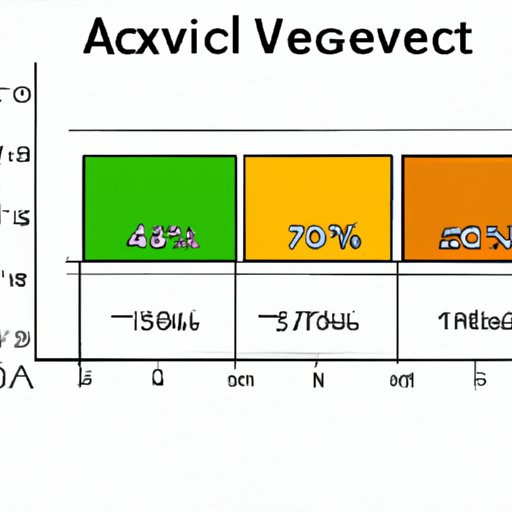Introduction
Have you ever wondered what an average is, or why it’s important to know how to calculate it? The average, also known as mean, is simply the sum of a set of numerical values divided by the number of values in the set. Knowing how to find an average can be extremely helpful in a variety of fields, from business to healthcare to education.
In this article, we’ll cover the three main methods of finding an average: the traditional method, using spreadsheet programs, and using statistical software. We’ll also explore the differences between regular and weighted averages, and provide examples of how averages are used in different fields. By the end of this article, you’ll have a comprehensive understanding of how to find an average.
The Traditional Method of Finding an Average
The traditional method of finding an average involves adding up all the values in a set and dividing by the total number of values in the set. For example, if you have a set of five numbers (3, 5, 7, 9, 11), you would add them all together (35), and then divide by the number of values in the set (5), to get an average of 7.
The advantage of this method is that it’s very straightforward and easy to understand. However, it can become cumbersome for larger sets of data. Additionally, it can be sensitive to outliers, or extremely high or low values that skew the average. For this reason, it’s important to be aware of common mistakes, such as forgetting to divide by the total number of values and mistaking the median for the mean.
Using Excel or Other Spreadsheet Programs to Quickly Calculate Averages
If you’re working with a large set of data, or just looking to save time, using a spreadsheet program like Excel can be a great option. Excel has built-in functions that can quickly calculate averages, such as the AVERAGE function, which takes the average of a range of cells. For example, if you have a data set in cells A1 to A5, you can use the formula =AVERAGE(A1:A5) to find the average.
Another useful function in Excel is the SUM function, which can add up a range of cells. By using both the SUM and the AVERAGE functions, you can quickly find an average for any data set. Excel also allows you to customize your calculations, such as excluding outliers or using a different type of average, such as the weighted average.
Using Excel or other spreadsheet programs can be particularly useful in situations where you need to perform calculations quickly, such as in business or finance. It’s also a great tool for visualizing data and spotting trends.
Explaining the Use of Statistical Software Like SPSS or R for More Complex Calculations
For more complex calculations, statistical software like SPSS or R can be extremely helpful. These programs offer a wide range of functions and tools that can be used to find averages and perform more advanced statistical analyses.
SPSS, for example, has a function called Descriptive Statistics, which can be used to find the mean, median, and mode of a data set. R has similar functions, such as mean() and median(), which can be used to find the average. These programs also allow you to analyze large datasets, create visualizations, and perform more complex calculations.
Discussing Weighted Averages and Why They May Be Appropriate for Certain Situations
While the traditional average works well for evenly distributed data sets, there are situations where a weighted average may be more appropriate. A weighted average takes into account the relative importance or weight of each value in the data set.
For example, if you’re calculating the average revenue per customer for a company, you might weigh the revenue generated by each customer based on their spending level. Similarly, if you’re grading students’ performances in a class, you might weigh certain assignments more heavily than others.
To calculate a weighted average, you’ll need to multiply each value in the data set by its corresponding weight, add up the results, and then divide by the total weight. For example, if you have a set of three numbers (2, 3, 4) with weights of (1, 2, 3), you would calculate the weighted average by multiplying 2 by 1, 3 by 2, and 4 by 3, adding up the results (2 + 6 + 12 = 20), and dividing by the total weight (1 + 2 + 3 = 6) to get a weighted average of 3.33.
Highlighting Some Specific Scenarios Where Finding an Average Can Be Useful
Knowing how to find an average can be useful in a variety of scenarios, from tracking business performance to gauging student progress. In finance, averages can be used to calculate returns on investment or assess market trends. In education, averages can be used to grade student performances or track class progress. In healthcare, averages can be used to analyze patient outcomes or measure the effectiveness of treatments.
It’s important to note that different types of averages may be appropriate for different situations. For example, in finance, the geometric mean may be more appropriate than the arithmetic mean for calculating returns on investments, as it takes into account the compounding effect over time.
Conclusion
Knowing how to find an average is an important skill that can be useful in many different fields. Whether you’re using the traditional method, spreadsheet programs, or statistical software, it’s important to be aware of the advantages and limitations of each method. Additionally, it’s important to understand the differences between regular and weighted averages, and to know when each may be appropriate. By practicing and seeking out additional resources, you’ll be able to confidently find averages for any data set.
